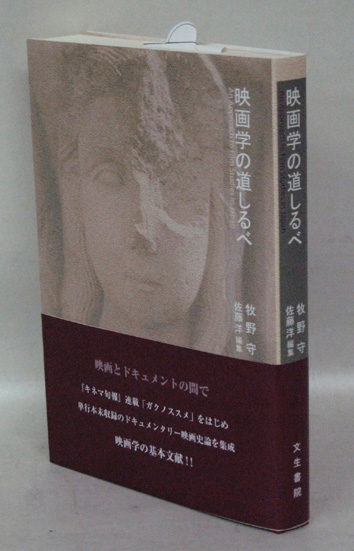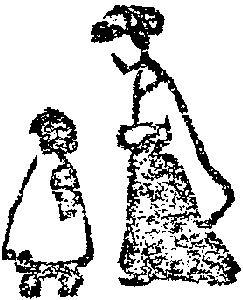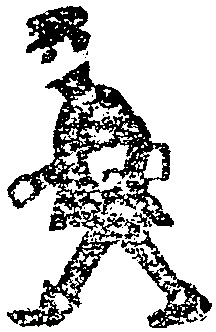 |
映画学の道しるべ
An Approach to Film Studies in Japan |
2011年9月29日発行
菊版・並製・370ページ 定価:2,800円(税別) ISBN 978-4-89253-472-0
装丁:杉本直子 印刷製本:モリモト印刷 発行:文生書院 |
映画とドキュメントの間で
『キネマ旬報』連載「ガクノススメ」をはじめ
単行本未収録のドキュメンタリー映画史論を集成
映画学の基本文献!! |
 はじめに はじめに
いま風のキャッチコピーの表現なら「どうなってる映画学の今」ということになるであろうか。かつて、映画の黄金時代、民衆娯楽の殿堂と称された映画街と映画劇場の姿はしのぶべきもない昨今である。しかしながらアカデミズムの学問上では、映画を主体とした映像分野について、映画学の議論がいよいよ熱気を帯びようとしている。
かつては、時代を表現した文化または芸術ジャンルの中でも、映画はサブカルチャー視されて、従来の古典的な芸術分野である文学、絵画、音楽に対して第七芸術あつかいをされてきた。
だが最近では、映画はメディア芸術という別格のカテゴリーによってくくられている。国際的にも日本の映画・TV・ゲームなどが、時代の魅力を創設するクールジャパンと称されて、新しい視聴覚表現様式を取り込み、アニメからマンガ、そして風俗としてのカワイイという価値観にもとづく、コスプレの装いの演出による、様々な活動も盛況を呈している。
映画が誕生してほぼ百年の世紀を経過して、本来の機能である、複製媒体での機械技術による集団性の創作基盤という、映像の原則的な性格は依然として、現在にいたるまで成立したままの形態である。それにもかかわらず、受容も含めたジャーナリズム批評分野の論壇が、この現況を追従する社会状況に対して、特に美学的見地からの本質的な解明が百年前の思考活動から停滞したままである。
このような問題意識を抱えて、果たして「我が国に映画学が成立するのか」という疑問を追究することで、筆者の研究が始まったのは一九五〇年代のことである。これが筆者の変わることないモチベーションとなっている。
このたび一冊にした映画に関する記述は、今では一昔前の言説を総括的にまとめたものである。この古風な発言が改めて問題提起することで、日本の独自な映画学の軌跡を実証することが出来るならば、筆者にとって望外の任を果たすことになると願っている。二〇一一年六月中旬
牧野 守 |
 目次 目次
| ガクノススメ |
|
|
1話 おいただきの神様
2話 テレビよ今夜もありがとう
3話 バナーディ先生の帰国
4話 N・Yのタクシードライバー
5話 今も昔 映画批評家の離合集散
6話 フィルムに昇華した清冽な光芒
7話 五月一三日金曜日の朝日新聞
8話 隠された背文字
9話 ちょっと気になる情報発信地
10話 日本映画史の「IF」
11話 ジェローさんがきたら伝えて
12話 映像から映画への回帰
13話 江古田映画学の底力
14話 旬報党 見参!
15話 わずかに日が射してきた幻の映画年鑑
16話 本邦映画博覧会史録 前篇
17話 本邦映画博覧会史録 続篇
18話 本邦映画博覧会史録 続々篇
19話 本邦映画博覧会史録 後篇34
20話 映画後進国の船出35
21話 マークさんの掘出物36
22話 近くて遠き国との映画交流
23話 震災のあと
24話 学芸員という仕事
25話 バスケットさんのナイスシュート
26話 戦時下映画統制のある終焉
27話 古書店々主の映画書評
28話 ミナト・ヨコハマ・シネマ
29話 四〇〇〇号達成の『ユニ通信』
30話 五九年前の日独合作映画の今
31話 映画書ツン読から目録作りの道
32話 NFCの4F
33話 映画博 極限上の創造力
34話 映画博のバックボーン 文献展示
35話 真夏のひとときの夢
36話 荒野を目指すのは青年ばかりではない
37話 終戦五〇年目の飯田にて
38話 地方紙の映画一〇〇年・戦後五〇年特集
39話 研究者の山形国際ドキュメンタリー映画祭
40話 先駆的業績を復元する努力と苦労
41話 松本克平さんの遺したもの
42話 映画が元気なまちの一一月
43話 サイレントへの華麗な挑戦
44話 以心伝心のデータ・ベース
45話 一九九五年、映画に死す
46話 CD-ROM上の、『キネマ旬報』
47話 銀世界の中国映画祭
48話 韓国映画博士第一号のスタンス
49話 釜山・シネマテック1/24
50話 研究交流と韓国映画資料センター
51話 ディムさんとの活弁問答
52話 映画文献資料収集の鬼の新面目
53話 三三・五キロの重さの意味
54話 日本映像学会第二二回大会にて
55話 『新しき土』と『Die neue Erde』
56話 韓国映画七五年の旧と新 |
|
57話 蝸牛の軌跡
58話 長春撮影所と満映の結び目
59話 研究者のフットワーク
60話 シーズンオフの九十九里探索
61話 映画都市釜山の九日間
62話 四冊目の映画文献資料研究会刊行物
63話 映画の学芸員教育実習の現状
64話 みちのく映画の旅
65話 映画が発言する満蒙開拓国際シンポジウム
66話 本郷界隈キネマ館懐古
67話 不滅なりや 小型映画
68話 『近代日本社会運動史人物大事典』の映画人
69話 海軍大佐との一期一会 前篇
70話 海軍大佐との一期一会 中篇
71話 海軍大佐との一期一会 後篇
72話 日本映画文献学のチャレンジャー
73話 横浜映画百年のオンパレード
74話 エイプリル・シネマ・フール
75話 続 エイプリル・シネマ・フール
76話 風土が育くんだ映画書誌
77話 泥絵具の無形文化財
78話 大盛一杯のSOMEN
79話 七夕の会余談
80話 発足した京都映画祭の画期的な提案
81話 NHK所蔵の映画文献資料
82話 ブルーバード懐かし銀座金春館
83話 オールド・パワーのシネマ・ラブコール
84話 NFCの新しいステップ
85話 下町の小津安二郎
86話 吉祥寺とアフリカ映画祭
87話 三つの映画祭の三人の女性作家
88話 シネマ・オープンシティ・調布
89話 奥多摩に出現したシネマ桃源郷
90話 作品と研究のダイナミックな饗宴
91話 雪のボストン、そして東京の夜は更けて
92話 柩を覆ってひとの評価は決まるか
93話 早春の映画研究日録
94話 上野昂志さん、いー仕事してますね
95話 戦時下ニュース映画の生き証人
96話 なぜNFC・4Fが気になるのか
97話 山田五十鈴、一期一会
98話 淀川長治さんの新しい遺言書
99話 日本の記録映画の肝っ玉母さん
100話 虎ノ門、日々是好日 前篇
101話 虎ノ門、日々是好日 後篇
102話 病床にて去り行く人を偲びて
103話 雷鳴轟く『羅生門』シンポジウム
104話 今年の映画学芸員実習のテキスト
105話 ケン・ローチの精神風土~文学と映画の間
106話 虎ノ門余話とモントリオール懐古
107話 台湾ドキュメンタリー映画祭への旅 前篇
108話 台湾ドキュメンタリー映画祭への旅 中篇
109話 台湾ドキュメンタリー映画祭への旅 後篇
110話 サヨナラの美学
111話 都の西北の情報発信基地
112話 映画五三年間の断絶の意味
113話 日暮れて道は遠し |
| 「記録映画史」の編纂 |
「記録映画史」の編纂について
「記録映画史」編纂
十字屋映画部と理科教材映画
ポール・ローサ『文化映画論』出版前後 |
| 記録映画の理論的動向を追って |
記録映画の理論的動向を追って
唯研の映画認識論争
STSについて |
| 日本プロレタリア映画同盟(プロキノ)の創立過程についての考察 |
| 映画における京都学派の成立 |
京都一九三〇年代の群像
加納竜一プロフィール
映画における京都学派の成立 |
| 映画文献をめぐって |
二〇年にわたる映画文献収集
今、映画文献資料の探索とは |
 紹介文 紹介文
|
映画史と運動史のために
藤井祐介 |
|
読みたかったものが読めることは有難いことである。牧野守氏の記録映画史研究が『ユニ通信』『記録映画作家協会会報』に掲載されたことを知ってはいたが、読んだことはなかった。この二つの掲載誌は入手・閲覧が困難であり、その存在を知りながら、現物を見たことがなかったのである。
このたび、牧野氏の論稿が本書『映画学の道しるべ』に収録され、二十一世紀の読者たちの手もとに届けられることとなった。これらの論稿は映画史研究の基本文献であるだけでなく、思想史研究・文化運動史研究にとっても無視することのできない仕事である。映画史研究者のみならず、他の分野の研究者にも味読を勧めたい。
味読すべきは細部である。例えば、牧野氏は、日本のプロレタリア映画運動がドイツの映画運動に影響を与えたことを指摘している(「記録映画の理論的動向を追って」)。牧野氏は、ベルリン滞在中の岡田桑三や千田是也によってプロキノの活動がドイツ国内で紹介されたことに言及しつつ、「日本とドイツの相関関係の一方の面」を明らかにしている。つまり、影響関係はドイツから日本へという一方的なものではなかった、ということである。ここでは日本からドイツへ、またドイツから日本へという相互の影響関係が問題になっているのである。
ここで確認すべきは、日本のプロキノの活動も日独文化交流史と無関係ではなかった、ということである。このように文化交流史の中に位置づけることによって明らかになる問題があるのである。岡田桑三や千田是也といったベルリン在住の左翼知識人の人脈については『ワイマール期ベルリンの日本人』(岩波書店)をはじめとする加藤哲郎氏の著作でも詳しく論じられている。
牧野氏の記録映画史研究は一九七〇年代に発表されたものだが、今日から見ても牧野氏が提示した論点は新鮮である。
また、牧野氏の先駆的な仕事が生み出された一九七〇年代という時代にも注目しなければならない。一九七〇年代はプロレタリア文化運動に関する研究が進展した時代でもあったが、牧野氏の論稿は同時代の研究動向を意識しながら紡ぎ出された。
一九七〇年代は「政治の季節」が終わった時代である。だが、それは「政治」が終わった時代ではなく、「政治」が変容した時代を意味する。一九七〇年代は蜷川府政、美濃部都政など革新自治体の時代でもあった。
終わったところから回顧がはじまる。一九七〇年代にはプロレタリア文化運動関係の資料集や復刻版が次々に刊行された。その一例を挙げるなら、『資料世界プロレタリア文学運動』(三一書房)、『日本社会主義文化運動資料』(戦旗復刻版刊行会)、『唯物論研究』復刻版(青木書店)などである。
この他に関係者による回顧や証言も発表されている。このことはプロレタリア文化運動にかかわった人々の世代とも関係する。日本のプロレタリア文化運動が最高潮に達した時期(一九三〇年前後)に二十歳であった青年が還暦を迎える年が一九七〇年である。本書で取り上げられている人物で言うなら、一九〇四年に生まれた加納竜一、〇七年に生まれた厚木たかと同世代の人々がプロレタリア文化運動の最盛期を経験しているのである。一九七〇年代になると関係者の高齢化とともに資料の散逸も懸念されていた。
牧野氏が同時代の研究動向に無関心でなかったことは、例えば、戸坂潤らの唯物論研究会について「今日、あらためて再評価されている」(「唯研の映画認識論争」)と述べていることからも明らかである。牧野氏の論稿は『唯物論研究』復刻版や『戸坂潤全集』(勁草書房)の刊行といった動きを視野に入れながら書き継がれたのである。
さらに、本書を読む上で忘れてはならないことは、牧野氏が想定する最初の読者の存在である。最初の読者とは牧野氏が執筆時に念頭に置いていた読者のことであるが、それは加納竜一や厚木たかといった映画運動の当事者たちに他ならない。論稿の一篇一篇は、加納や厚木に宛てた手紙でもあったのである。
牧野氏の研究と資料収集の原動力は、このような最初の読者の存在にあった。「すこしのことにも、先達はあらまほしき事なり」とは兼好法師の言葉である。映画史研究という大海を渡る時にも「先達はあらまほしき事」である。牧野氏にとっては加納竜一や厚木たかが「先達」であった。若い世代の読者たちには本書が「先達」の役目を果たすことになるだろう。 |
|
|
牧野先生のススメ
アーロン・ジェロー |
私が牧野守という名前に遭遇したのは、日本に来るずっと前でした。アメリカのある大学図書館のために、購入すべき日本映画関係の出版物のリストを作成していたら、牧野守という人が編集に携わっている古い映画雑誌等の復刻版がいくつか出てきたからです。このような資料を収集してこなかった海外の研究施設にとってばかりでなく、日本の映画研究を築き上げようと志す者にとってさえも、このような「資料提供」はまさに励みになる出来事だったのです。そして私は牧野守という名前を心に刻み込みました。
いざ日本でこの牧野守なる人物にお会いしたら、それこそまさに「提供精神」を身近に接することができたのです。ご自宅にお邪魔して、そうめんのお相伴にあずかりながら、ご自身のコレクションの数多くの貴重な資料を閲覧させていただきました。そのご協力のお陰で、初期映画時代の言説史に関する博士論文を完成させ、後に『Visions of Japanese Modernity』 として上梓することができました。
その提供精神の背景にあったのは、個人収集家にありがちな自己誇示からほど遠い、あくまでも映画学のあるべき姿のヴィジョンでした。『映画学の道しるべ』にも収められている『キネマ旬報』の「ガクノススメ」というタイトルも、 牧野先生のヴィジョンを何よりも表現していると言えます。先生から資料提供等をいただいた研究者の協力のもとにできた記念論文集『In Praise of Film Studies 映画学ノススメ 牧野守に捧げる』も、まさにその姿勢を讃えています。
牧野先生の映画学をススメている活動は、資料の提供や学問の促進といった行動にとどまっておらず、研究分野の先端に立っていることをも意味しています。『Visions of Japanese Modernity』から『A Page of Madness』や『Kitano Takeshi』までの私の研究活動は、映画という現象を深く理解するために、作家や作品の分析だけではなく、それらをめぐる言説の歴史をも研究の対象にしなければならない、という牧野先生の基本の理念から多大な影響を受けています。現在研究している日本の映画理論の歴史においては、世界でも希なる高度な思考を持つ理論家が数多く存在するにも関わらず、作家論に取り憑かれている今までの映画研究においてはほとんど無視されるという状況が、残念ながら続けています。その中で、貴い例外といえるものは、中川重麗をはじめとする京都映画学派をめぐる牧野先生の研究でありましょう。
牧野先生ご自身の研究も一種の資料提供です。先生の研究姿勢から伺えるのは、この課題に関する最終の結論というよりもむしろ、他の研究者に対して、どうぞこの研究をさらに自由にススメてください、という印象を私は受けます。これもまた「ガクノススメ」のもう一つのあり方ではないでしょうか。私もこれから 先生の後を追って喜んで研究をススメていくつもりです。 |
|
My Memory, My Sanctuary
Abé Mark Nornes |
Here is what it was like.
Kokubunji is far enough down the Chuo Line that I had never been before my first visit to the home of Makino Mamoru. It is a pretty typical suburban station. One side of the tracks is the “back” by virtue of its lack of shops, which quickly give way to Japanese suburbia. The “front” has the obligatory taxi circle, itself circled by tall, thin commercial buildings. The only shop of interest is long gone, a used book store that merited the occasional visit to see if anything new popped up on the shelves. Nothing worth buying ever appeared in that bookstore, and I attributed this to its proximity to Makino Mamoru’s home. The used bookstores on the Chuo Line are otherwise pretty reliable.
The route to the house is a jagged trek south and down the hill. I could never remember it with any precision. Veer left. That was my only rule. At the bottom of the hill there is one stretch of walking path that crosses a stream and enters a tunnel-like canopy of trees, liberating one from traffic noise and the nuisance of cars. I have heard there are nice parks, paths and temples in the area, but I never took the time to visit them. My singular goal was always Makino Mamoru’s house, and my time there was precious.
From the outside, the house looks like any other in the neighborhood. Today, the inside is similarly typical. However, back when I first started visiting the Makino family, the interior was legendary. Standing in the entryway, the first thing one noticed was the staircase leading upstairs, which was narrowed by stacks of books sitting on every riser. It invited one to wonder if they led to more piles up in the family inner sanctum of the second floor. Passing the staircase, one entered the tatami room where Makino Mamoru held court on a low table. I suppose it was a six-mat room, but there were at least seven bookshelves against the walls. Their shelves featured his reprint collections and the monographs of scholars who Makino helped over the years. Both of these “series” expanded over the years, crowding out other books that he gradually moved to the back rooms.
Next to this room was the family room, followed by what I suppose would be called a study. It was a year or two before I was invited to explore this mysterious space in the back of the house. Passing through the family room, one came face-to-face with a wall of shelves. It snaked around and back, creating a narrow canyon of bookshelves along the side of the room. At the far corner of the house, the corridor hooked left, and then left again. At the end of it all was a tiny area to work in. Every visible surface between the floor and ceiling was shelving, each nook stuffed to the gills with books. Seen from above, it was the shape of a snail shell.
The materials I spent the most time with were way back on the other side of the house, in a room next to the tatami room. Makino positioned the shoji for its doorway right in the middle, effectively creating two narrow entrances. Inside, back-to-back bookshelves bisected the space, creating two square rooms. Needless to say, all the other walls sported bookshelves as well. I suppose I first visited the strange Makino home in the early 1990s, and back then all the shelving fully adorned with books from every era of film history. It was an extraordinary spectacle.
There was always an influx of new books fighting for space in the shelving. Makino had his network of booksellers. There were donations from friends. And he was always on the hunt. I recall visiting Kyoto with him one year for a conference. He travelled admirably lightly. However, moving through the city he would drop everything in order to check out used bookstores. By the end of the conference he had amassed so many books he couldn’t carry them all by himself. In this manner, there was a constant flow of new books looking for space, and when there were no shelves left he created stacks on the floor of the two mini-library rooms. These stacks got taller and taller every time I visited. As they became unmanageably high, a second layer of stacks appeared on the floor. It wasn’t long before it was pretty much impossible to enter these rooms. It’s a wonder the house didn’t collapse from all the weight.
Most avid collectors possess a commanding grasp of history behind their object of desire, but they also tend to let their hoarding tendencies get the best of them. For this reason, collectors often fail to share their knowledge, let alone share the riches they amass. Makino was decidedly different, and for this reason the collection was unusually “productive.” The most overt expression of this is Makino’s devotion to the tradition of reprinting. In this way, Makino shepherded core books and periodicals from his piles to the shelves of scholars and libraries across the world. Another expression would be Makino’s own scholarship; rich with quotes, it is a kind of reprinting embedded in historical analysis. We find excellent examples of this in the latter half of Eigagaku no Michishirube—essays that were invaluable guideposts for my own research into Japanese documentary. However, I would like to call attention to two other kinds of productivity connected to the Makino Collection, as they are important facets of his 1990s Kinema Junpo column “Gaku no susume.”
The first has to do with programming. “Gaku no Susume” has a surprising number of columns devoted to film festivals and exhibitions. In fact, back in the 1990s there was an explosion in the number of film festivals around the world, whether they were on the so-called A-list, themed, or local affairs. Japan participated in this phenomenon, with new festivals appearing in Tokyo, Yamagata, Fukuoka, Yubari, and many other cities. However, one new wrinkle on the festival was a devotion to thinking about film history. There was nothing new about retrospectives, but many of these festivals attempted to do more than simply collect and show a group of films. Makino’s columns on Yamagata and Kyoto, as well as the exhibitions in Yokohama and the Film Center point to this new aspect of film culture. Indeed, many of the programmers were serious enough about exploring the context for their historical retrospectives that they found themselves sitting in the book-filled tatami room in Kokubunji.
A second expression of the productivity of the Makino Collection had to do with foreign visitors to the house. Most collectors don’t want anyone touching their objects of affection. In contrast, Makino was remarkably generous. It is probably true that he was probably more helpful to foreign scholars. This certainly comes out in the pages of “Gaku no Susume,” which offer up portraits of scholars from the US, Germany, Korea and China. Perhaps this has something to do with his evangelical zeal when it came to matters pertaining to Japanese film history. Whatever the case, I would like to point out a thing or two about the visits by American scholars.
Makino opened his collection to quite a few American graduate students starting in the 1990s. A few get nods in “Gaku no Susume.” These include Joanne Bernardi (Episode 3), Aaron Gerow (Episodes 11 and 54), myself (Episodes 12 and 21), Michael Baskett (Episode 25), and Jeffrey Dym (Episode 51). This was an interesting moment in Japanese film studies in North America. Film studies itself was highly professionalized and fully entrenched in the academy. However, up to this point there were few scholars other than Donald Richie and Joseph Anderson—the pioneers writing in English—who could read and speak Japanese. The scholars of the 1960s through 1980s managed to produce a powerfully influential body of work, but their inability to access the riches of the archive meant that there was plenty of historical spadework left to do.
And the virgin dirt for this work was sitting in that house in Kokubunji. Makino opened his home to the first wave of American graduate students that could read Japanese. But he was no mere gatekeeper. He would pull out stacks of materials for us to read, sit down and then provide historiographic contextualization for the archival dive of the day. Coming up for air, he would act as sounding board for emergent ideas on their way to print. His timing could not have been better. There is surely a bit of Makino in all the books by those that sat on that tatami, surrounded by books.
“Gaku no Susume” provides a curious glimpse at this pivotal moment in the English-language study of Japanese cinema. Along with its attention to transformations in film festival culture and the growing interconnections with East Asian cinema, it stands as a unique portrait of 1990s Japanese cinema world. I treasure “Gaku no Susume” because all this is an enormous part of my own memory of turn of the century Japanese film—that and those pleasant walks through the neighborhoods of Kokubunji, on my way to that sanctuary of film books. |
|